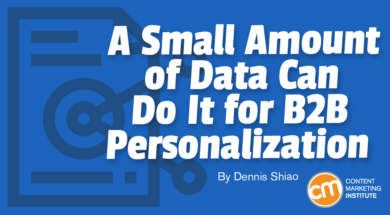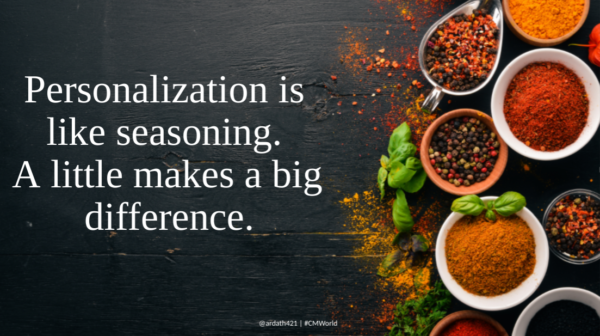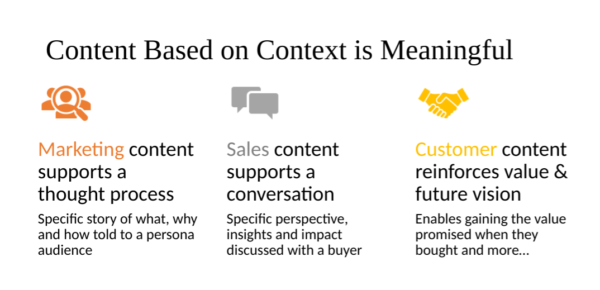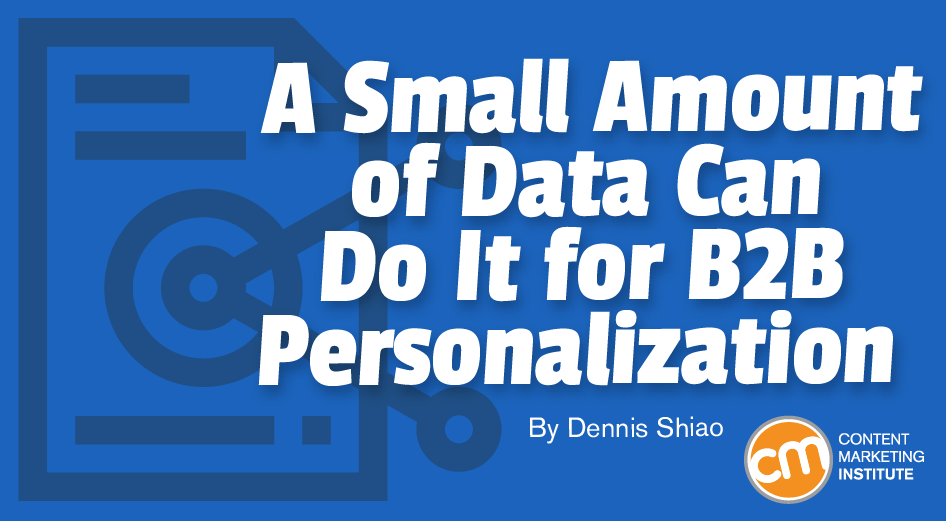
Bring up the topic of personalization and marketers undoubtedly reference Amazon and Netflix.
Amazon has an uncanny way to recommend related products to add to your shopping cart, while Netflix knows just the movie or show you’re in the mood for. While their personalization is indeed fantastic, they have a big advantage: your customer data. Amazon knows your detailed purchase history, while Netflix knows your detailed viewing history.
How can we create personalized experiences to acquire new customers? Looking at the success stories of Amazon and Netflix, we believe a detailed profile of user demographics is required. But in B2B marketing, detailed demographic and psychographic profiles aren’t needed. In fact, a small amount of data combined with relevant insights can go a long way.
A small amount of data combined with relevant insights can go a long way, says @dshiao via @cmicontent. #CMWorld Click To TweetIn her Content Marketing World presentation, Personalization that Drives Profitable Engagement, Marketing Interactions CEO Ardath Albee says, “In B2B, we don’t need to know their shoe size and we don’t need to talk about their gender. We don’t need to know they live in the suburbs and have a wife, two kids, and a dog, and they drive a red Corvette.”
So let’s consider what will help a B2B vendor sell more software (or anything else).
Cup of data with a dash of industry insight
“Personalization is like seasoning. A little makes a big difference,” Ardath says.

In cooking, a pinch of the right spice can make the meal, while a pinch of the wrong spice can spell disaster. With personalization, prospect data is like a pinch of spice.
With personalization, prospect data is like a pinch of spice, says @ardath421 via @cmicontent. #CMWorld Click To TweetArdath tells the story of a cold outreach email she received. It labeled her as the CMO of Marketing Interactions. A quick check of LinkedIn would have provided the sender Ardath’s correct job title: CEO. “How long do you think that email sat in my inbox before I hit the delete button? It doesn’t take very much to turn people off,” she says.
Corporate Visions, a marketing messaging and sales skills training company, conducted personalization research – Putting Personalization to the (Field) Test (registration required). As Ardath explains, the real-world field trial involved sending emails to 7,000 names in the company’s prospect database. Each recipient fit their ideal client profile but had no prior interaction with Corporate Visions.
It used four varieties of personalization:
- Industry only – subject line and opening had a relevant industry insight
- Company only – unique angle based on recipient’s company news or information
- Personal and industry – personal details added to the industry-specific email
- Personal and company – personal details added to the company-specific email
The personal-and-company email had higher open rates, while the industry-only emails had higher clicks and scheduled meetings. “In fact, (the industry email) had 24% higher click-throughs, and it had almost 50% higher meetings set,” Corporate Visions’ Tim Riesterer said in an interview at Demand Gen Report.
Industry-only personalized emails had higher clicks and more meetings set, says @TRiesterer via @dg_report. @cmicontent Click To TweetThese findings make sense to me. While it’s easy to insert a prospect’s first name or company name into an email subject line, it takes more work to research and share insights specific to a prospect’s industry.
Let’s look at the sample email for the industry-only email. The intended recipient is in the financial services industry:
A host of smart, insurgent start-ups are poised to change the financial services industry more in the next ten years than it has in the past one hundred, according to CBInsights. Because of this, there’s never been a higher premium on being able to articulate your story simply, concisely, and compellingly.
Good opening, right?
While seeing your name in the subject line might cause you to open it, the body of the email may disappoint. As the Corporate Visions report explains in its conclusion: “(W)hen we discover the underlying gimmick – that is, someone plucked a random fact from our LinkedIn profile and used it to suck us in – the letdown factor is enough to preclude further action.”
Including relevant industry insights activates the prospects’ sense of voyeurism, especially when the insights relate to other companies in the same industry (i.e., their competitors). The report states, “So when you share a story about how a similar company struggled and solved a common industry concern, (the recipients are) better able to project themselves into the story and eager to find out what happened next.”
To summarize, you don’t need deep demographic and psychographic profiles to succeed in personalization. Sometimes it’s just a dash of data, combined with insights directly relevant to a prospect’s industry.
HANDPICKED RELATED CONTENT:
Content based on context
Content supports personalization efforts only when the right content is provided in the right context. Ardath covers three types of this content – marketing, sales, and customer.
Context matters in #content personalization. Is it marketing, sales, or customer focused? @ardath421 via @cmicontent #CMWorld Click To Tweet
Marketing content supports a thought process. “It’s a specific story of why, what, and how somebody needs to change based on the problem they’re trying to solve in relation to a specific persona,” Ardath says.
Sales content is less about a thought process and more about driving a conversation – the conversations sales reps have with prospects. This content should reinforce and augment the previous interactions between the salesperson and the prospects.
Customer content reinforces the promise customers were given when they purchased a product. It helps customers understand and realize future value. This type of content is especially important in today’s subscription-based vending world.
“We’re not selling big, long-term, heavy-duty contracts anymore. It’s now subscriptions,” Ardath says. “Acquiring customers is important, but keeping them is doubly important. We can actually grow our companies faster if we can keep and expand the accounts we already have.”
HANDPICKED RELATED CONTENT:
Hook without alienation
When you successfully use personalization to attract and engage the right prospects, the last thing you want to do is alienate them. Yet, marketers often do that.
We’ve all run marketing campaigns with a theme and goal to be achieved in a set period (i.e., this month, this quarter, this year). When that time is over, the marketing team celebrates achieving its goal and moves on to the next campaign.
But wait! What about the 1,000 marketing-qualified leads the campaign generated? Is anyone paying attention to them? A customer’s purchasing timeline often doesn’t align with a marketing campaign time span. It may ebb and flow over the course of weeks, months, or years. If your brand is not “there” when the prospect needs you, the deal may be lost.
Ardath says, “The prospect is sitting there going, ‘Wait, where’s the rest of the information? Where’s the rest of my story? I was just getting into this. I have a lot more to do.’”
Another potential alienation opportunity is the marketing-sales handoff. I equate this to interactive voice-response systems. I call customer support and provide my name, account number, and PIN. I go through a few menus before I can speak to someone. Finally, I’m passed through to a customer service representative who asks my name, account number, and PIN.
How frustrating!
This is the same feeling experienced by prospects during a poor marketing-sales handoff. Marketing drives the front end of the experience with the website, white papers, and webinars. Through form completions and chatbot interactions, a lot of data has been collected about prospects. But when they’re ready to speak to sales, they’re asked for the same information they provided, leaving them to think at worst that the company doesn’t care about listening to them or at best the company isn’t communicating well internally.
Last, but not least, don’t make prospects search far and wide for the next piece of relevant content. Ardath explains, “We need to group our content into experience hubs. We want prospects to say, ‘OK, here are the pieces of the story. Let me watch this video, then read this case study.’ Create a choose-your-own-adventure experience. We have to help them find things and make it easier.”
HANDPICKED RELATED CONTENT:
Personalization: what’s next?
I think personalization is still in the Dark Ages. Is this due to technology, process, implementation, governance, or all of the above? The approaches (e.g., a little bit goes a long way) shared by Ardath are smart and work.
But where to next? Will new software vendors emerge to crack the nut? Will digital experience platforms improve their personalization features? Will artificial intelligence be the true answer? I’m excited to discover the answer. Where are you in your personalization journey? Are you satisfied with where you are? Is there something holding you back? Share your experiences in the comments.
Here’s an excerpt from Ardath’s talk:
HANDPICKED RELATED CONTENT:
You can personalize your content marketing education journey this October at Content Marketing World. Follow theme-specific tracks or pick and choose topics presented by over 100 speakers. Register today!
Cover image by Joseph Kalinowski/Content Marketing Institute

